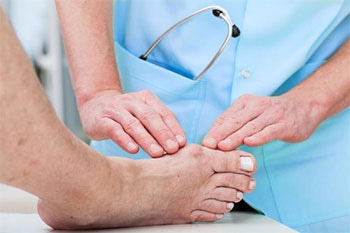What’s the difference between a Bunion (Hallux Valgus) and Big Toe Arthritis (Hallux Limitus)?
It is not at all unusual for patients to confuse bunions and big toe arthritis because both these conditions can cause pain and a bump and enlargement at the big toe joint. But they are actually very different conditions.
While you can delay bunion treatment until the bunion becomes painful, the treatment of hallux limitus (big toe arthritis) is so important in the early stages. For this reason, a proper diagnosis by a foot and ankle specialist is crucial.
What’s a Bunion?

So in the case of a bunion, as the bones move out of their normal position, the tendon pulls the great toe inwards, much like the string of a bow-and-arrow.
This starts out as a minor annoyance, but then (sometimes quickly) becomes a bigger problem when shoes rub on the bump. When that happens and the pain begins, it’s very wise to see a podiatrist.
While there is no major limitation in the range of motion from a bunion, if the deformity progresses unabated, the great toe joint can dislocate.
Then your minor pain will progress and you’ll start to experience significant joint pain and degeneration.
What’s Big Toe Arthritis?
Big Toe Arthritis, also know technically as “Hallux Limitus” or “rigidus arthritis of the great toe joint”, occurs when the big toe (1st metatarsal) moves upwards or begins to form bone spurs, which limits the range of motion of the toe. The jamming of the joint causes pain, swelling, and tenderness with activity.
Many people are predisposed to big toe arthritis because of the bio-mechanical make-up of their toe joints. It can become much worse after an injury or repetitive movements like high-heeled shoes and some sports.
The symptoms of big toe arthritis are different from those of bunions. Big toe arthritis usually starts with a feeling of stiffness of the joint and often swelling and redness.
This usually progresses to a decrease in range of motion, a crunching feeling when moving the joint, and then a bump that forms toward the top of the joint, not the side of the toe like bunions.
The pain of hallux rigidus is a result of arthritis in the joint, bone spurs, and possible loose bodies that break off from the bone spurs. The pain from a bunion, on the other hand, is caused by the bump rubbing on the side of the shoe.
Can a Bunion and Big Toe Arthritis Occur Together?
Sadly, yes they can. And when a bunion and big toe arthritis occur together it is a more complex foot deformity.
Sometimes arthritis accompanies a bunion due to the abnormal position of the joint. Usually, the bunion deformity has progressed by repetitive trauma or a distinctive injury. Thus begins arthritis.
There can also be a bunion component to big toe arthritis because the bone can move a bit over. This is often corrected at the time of the joint clean-up.
Bunions vs. Big Toe Arthritis: How Their Treatments Vary
Hallux limitus (big toe arthritis) is crucial in the early stages. Once you have destroyed the cartilage in your joint, there’s nothing anyone can do to make more. Research is underway trying to replace or regrow cartilage, but we are many years from a solution.
Hallux limitus in the early stages is controlled with a custom orthotic, which helps take pressure off the big toe and redistribute it through the rest of the foot. A clean-up procedure known as a cheilectomy removes scar tissue and spurs from the joint. This allows for a better range of motion and slows arthritis’s progression.
Some patients can really benefit from a surgical procedure to realign and shorten the metatarsal to give the joint better biomechanics and joint space. Unaddressed Hallux limitus leads to complete joint destruction and the need for a toe fusion or joint replacement.
If joint replacement is recommended, rest assure as our physicians have successfully performed more Cartiva implant procedures than any other clinic in Southern California. Cartiva is a new, gel-like implant that offers significant pain relief while preserving range of motion in the joint. Recovering from a Cartiva implant surgery is much easier than recovery from a fusion surgery or metal joint implants. Read more about Cartiva here.
The flip side of this is that patients with your traditional bunion can often delay treatment until they start to have pain. Bunions in the early stages are considered a cosmetic concern.
The joint is usually not damaged until the later stages but it is important to seek medical attention once it starts to hurt so the joint is not permanently injured. But a bump, in the absence of pain, can wait.
- Revolutionizing Extremity Imaging: UFAI’s Open MRI for the Foot and Ankle - October 21, 2023
- Youth Sports and Heel Pain: Should Kids Play with Pain? - April 4, 2023
- All About Foot Arch Pain and Foot Arch Cramps - March 15, 2021
After reading your article, it has come to my understanding that my mother-in-law has a bunion. However, I founded interesting when you specified that big toe arthritis could crop up bunion as well. I will definitely take her to a nearby Podiatrists for a better result and a treatment.